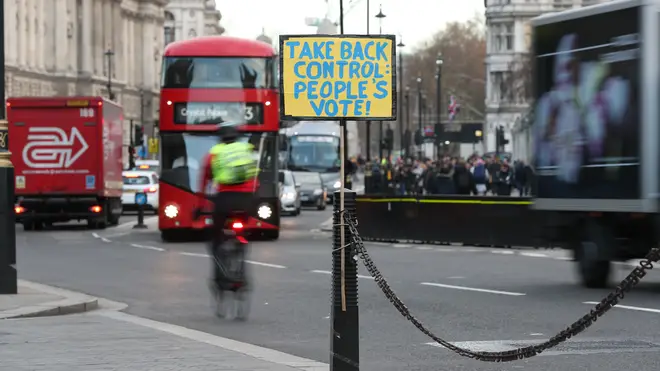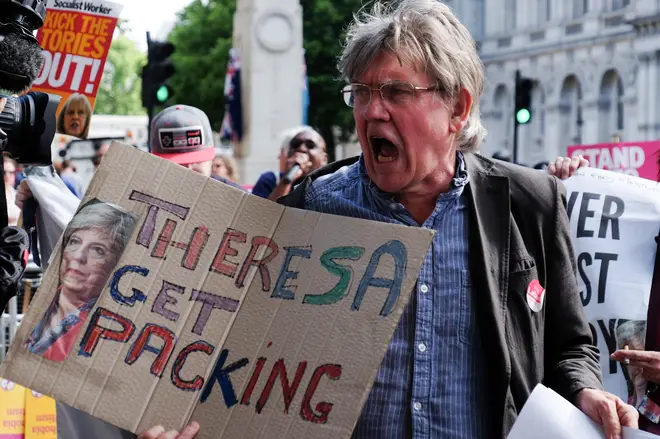
Shelagh Fogarty 1pm - 4pm
10 January 2019, 12:31 | Updated: 28 October 2019, 15:53
What will Theresa May's Plan B be if she loses the meaningful vote as expected? LBC's Political Editor Theo Usherwood assesses her options.
If the Prime Minister loses the vote on her exit deal, she must return to Parliament to set out her Plan B within three working days.
What will that Plan B look like? Here is what she might do next.
Theresa May will no doubt speak to Donald Tusk and Jean-Claude Juncker in the immediate aftermath of Tuesday’s vote. If – as expected – she loses, her job will be to persuade them both that she could win second time round if they are forthcoming with more substantial concessions.
The offer would have to be much better than what we have seen over Christmas, but the EU has plenty of other things to worry about other than Brexit. The growing feeling in Brussels is that a deal needs to be done. That would give the PM one last chance to get something better, and bring the vote back to Parliament towards the end of January, or the beginning of February.
Likelihood rating: 4/5
Mrs May would need to immediately ask the EU for an extension to Article 50. She has of course repeatedly ruled out a second referendum. The argument from Number 10 is that the British people has already had its say and we voted to leave.
The obvious strategy would be to put three options on the ballot paper: Remain, May’s deal, No Deal. That risks enraging leavers as it splits their vote in two.
But a second poll doesn’t necessarily have to reverse the 2016 result. Mrs May could propose the question: My Deal or No Deal? That would put the onus on Jeremy Corbyn to order his MPs to vote for the inevitable amendment to add Remain to the ballot paper. A high risk strategy for a Prime Minister most do not think actually countenances leaving without a deal.
Likelihood rating: 2/5 (May deal v No Deal: 1/5)

Last month’s no confidence vote was politically costly because Mrs May had to promise she would not fight the next general election in 2022. The date is important: the Prime Minister leaving open the option that she could call a snap general election and fight it.
On the plus side, it is the only way to break the deadlock in the House of Commons. We are where we are because as things stand at the moment there isn’t a majority for anything.
On the downside, it is hard to imagine senior Tories within the party allowing Mrs May to fight a snap election, especially after what happened last time. Given the internal turmoil within the Conservative party at the moment, it is also hard to see how Mrs May could campaign with a coherent message to win over voters. Needless to say, this is the ideal route for Jeremy Corbyn. Just like the previous option, Mrs May would need to extend Article 50.
Likelihood rating: 2/5
Similar to option one, this course of action relies on Downing Street buying, with the help of prevarication in Brussels, as much time as possible. A tough ask but Downing Street’s consistent argument to Remainers has been that they should vote for the PM’s deal or face a No Deal Brexit because that is the default option. The closer we get to Brexit D-Day – March 29 – the more powerful this argument becomes.
The only problem is the Government has to pass six pieces of Brexit legislation (excluding the Withdrawal Agreement and Implementation Bill) by 29th March, on everything from immigration to fisheries. Given what happened with Yvette Cooper’s amendment on Tuesday to the Finance Bill, those pieces of legislation would be cut to shreds by Tory Remainers and Labour in an effort to grind the machinery of Whitehall to a halt.
The problem for the Prime Minister is that she will lose increasing amounts of control the closer she gets to D-Day. And then there is the strong chance Remainers in the Government will knock on the door and tell her to go, or face mass resignations.
Likelihood rating: 3/5
It is worth including but it is not going to happen, not least because it wouldn’t get through Parliament. Jeremy Corbyn wouldn’t support it and it would end in a bloodbath for the Conservatives at the next election.
Likelihood rating: 0/5
The problem at the moment is that MPs cannot decide between themselves as to what to do. Mrs May could announce next week that she will hold a series of indicative votes in an effort to build a consensus.
There have already been discussions with Labour MPs in leave constituencies – the likes of John Mann and Caroline Flint - but given the splits within her own party, Mrs May will probably need Jeremy Corbyn to whip his MPs to support her next move.
A softer Brexit pushed through by Labour MPs will damage the Tory brand and cause uproar amongst leavers within her own party. And for a Labour leadership focused on a general election, it is not particularly desirable to let the PM off the hook. But then the Labour leader won’t exactly relish a second referendum and the implications for his unity within his own party.
Likelihood rating: 3/5

This is the last thing the Prime Minister is going to do. Theresa May had wanted the chance to implement her own domestic agenda to resolve the burning injustices she saw in society when she walked in to Number 10 in July 2016. That won’t happen now.
Brexit is her mission, and it is one she is determined to fulfil. But there has been speculation in recent days that her most senior aides are looking for a way out once the first stage of Brexit is over. If this happens, Mrs May would then have to revive her office with fresh staff and impetus to complete the lengthy and tortuous trade negotiations, not to mention deliver on her reforms to the social care system and education. A seemingly impossible ask.
Likelihood rating: 0/5 before Brexit, 4/5 after Brexit